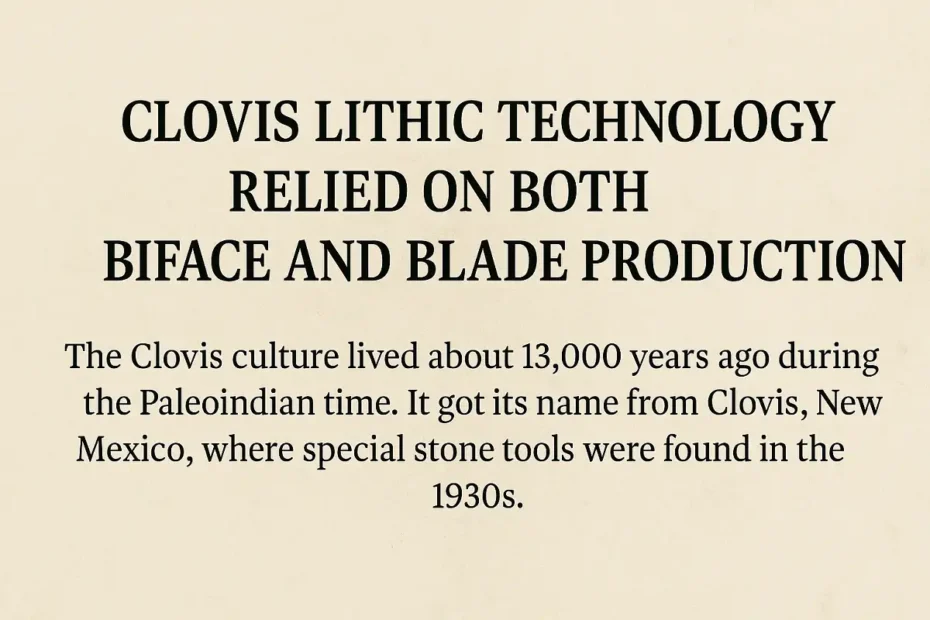When studying ancient North American cultures, the Clovis people often take center stage due to their groundbreaking stone tool technology. Clovis lithic technology relied on both biface and blade production, revealing a level of sophistication and adaptability that was previously underestimated. These early inhabitants of North America left behind distinct fluted projectile points and tools that provided insights into their daily lives, survival strategies, and migration patterns.
This article explores how the dual use of biface and blade production defined Clovis lithic technology, what it tells us about early humans, and why it remains a focal point in archaeology today.
Who Were the Clovis People?
The Clovis culture lived about 13,000 years ago during the Paleoindian time. It got its name from Clovis, New Mexico, where special stone tools were found in the 1930s. These tools, primarily found in North America, were associated with the bones of extinct megafauna like mammoths and mastodons, suggesting that Clovis people were big-game hunters.
The Hallmarks of Clovis Lithic Technology
Archaeologists have admired how well-made and useful Clovis tools are for a long time. Unlike earlier technologies, Clovis lithic technology relied on both biface and blade production, which made it more versatile and efficient. Here’s a breakdown of these two major components:
Biface Production
Biface tools are created by flaking stone on both sides to form sharp, symmetrical edges. This technique was not unique to Clovis culture, but its application was perfected by them. The most famous example of a biface tool from this period is the Clovis point — a fluted, lance-shaped projectile used for hunting.
These bifacial tools were multipurpose. They could be used as knives, spear points, or cores for producing smaller flakes. Their manufacture required skill and foresight, demonstrating the Clovis people’s advanced understanding of tool-making techniques and material properties.
Blade Production
In addition to bifacial tools, Clovis artisans produced long, thin stone blades struck from specially prepared cores. Blade production is considered more advanced because it allows for more cutting edge per unit of raw material, making it highly efficient.
The use of blades implies not just functional ingenuity, but also planning and organization in tool production. These blades were often used for butchering animals, scraping hides, or woodworking.
The Significance of Dual Production Methods
The fact that Clovis lithic technology relied on both biface and blade production suggests a high level of technological sophistication for such an early culture. Most prehistoric groups specialized in one technique, but Clovis people adapted their approach to different needs and environments. This dual strategy may have contributed significantly to their survival and spread across the continent.
Blades allowed for precision and economy, while bifacial tools offered durability and versatility. This combination ensured that Clovis toolkits were both portable and comprehensive — ideal for a mobile, hunting-based lifestyle.
Raw Materials and Resource Selection
Clovis artisans were selective in choosing high-quality stone materials like chert, flint, and obsidian. They often traveled long distances or traded with other groups to acquire the best raw materials. This selective behavior underscores how Clovis lithic technology relied on both biface and blade production that required not just skill, but also strategic planning.
Cores and preforms — partly shaped stones — found at various Clovis sites indicate that these people prepared materials in advance for future tool-making, a further sign of their foresight and organizational ability.
Archaeological Evidence Across North America
Many archaeological sites from New Mexico to Nova Scotia show that Clovis tools were used in many places.Sites like Blackwater Draw (New Mexico), Gault (Texas), and Topper (South Carolina) have yielded thousands of artifacts demonstrating that Clovis lithic technology relied on both biface and blade production in diverse environments — from plains to forests.
At many of these sites, researchers have discovered evidence of both production techniques in use simultaneously, reinforcing the idea that Clovis people were not merely opportunistic but practiced systematic, planned manufacturing.
Debates and Discoveries
While Clovis technology has long been considered the “first” American toolkit, recent discoveries suggest other cultures may have predated it. However, this doesn’t diminish the significance of Clovis innovations. If anything, it highlights how Clovis lithic technology relied on both biface and blade production to an extent unmatched by their contemporaries.
This adaptability may have provided a competitive edge that allowed them to thrive where others didn’t. The high degree of craftsmanship and tool standardization points to a shared cultural knowledge base, possibly passed down through generations.
Legacy and Importance in Modern Archaeology
Clovis tools still help archaeologists learn about how humans moved, changed, and created new things. Because Clovis lithic technology relied on both biface and blade production, it represents a crucial phase in human technological evolution.
Modern experimental archaeologists attempt to recreate Clovis tools using traditional methods to understand the challenges and skills involved. These efforts often reveal just how advanced the Clovis toolmakers truly were — combining functionality, beauty, and efficiency in every piece.
Final Thoughts
In summary, Clovis lithic technology relied on both biface and blade production, creating one of the most effective and versatile toolkits in prehistoric America. This dual approach to stone tool manufacturing shows a remarkable blend of practicality and foresight, making the Clovis culture a milestone in human innovation.
Their legacy lives on through the artifacts unearthed across the continent, each one telling a story of ingenuity, survival, and progress. As we continue to study and learn from these ancient tools, we not only uncover our past but also gain insights into the resourcefulness that defines human history.
